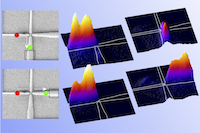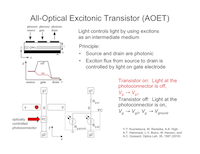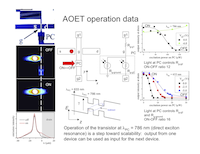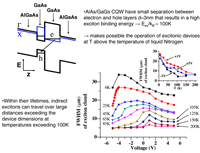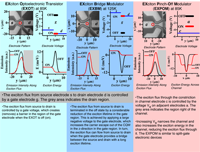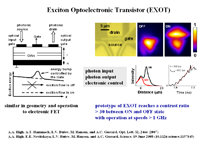Optically controlled excitonic transistor |
|
Optical control of exciton fluxes is realized for indirect excitons in a crossed-ramp excitonic device. The device demonstrates experimental proof of principle for all-optical excitonic transistors with a high ratio between the excitonic signal at the optical drain and the excitonic signal due to the optical gate. The device also demonstrates experimental proof of principle for all-optical excitonic routers. P. Andreakou, S.V. Poltavtsev, J.R. Leonard, E.V. Calman, M. Remeika, Y.Y. Kuznetsova, L.V. Butov, J. Wilkes, M. Hanson, A.C. Gossard. Optically controlled excitonic transistor, arXiv.org:1310.7842 (2013), Appl. Phys. Lett. 104, 091101 (2014). |
|
All-optical excitonic transistor |
|
We demonstrate experimental proof of principle for all-optical excitonic transistors where light controls light by using excitons as an intermediate medium. The principle of operation of all-optical excitonic transistors is based on the control of exciton fluxes by light. Y. Y. Kuznetsova, M. Remeika, A. A. High, A. T. Hammack, L. V. Butov, M. Hanson, and A. C. Gossard, All-optical excitonic transistor, Optics Letters, 35 (10), 1587-1589 (2010). |
|
Excitonic switches operating at 100 K |
|
Photonic and optoelectronic devices may offer the opportunity to realize efficient signal processing at speeds higher than in conventional electronic devices. Switches form the building blocks for circuits, and fast photonic switches have been realized. Recently, a proof of principle demonstration of exciton optoelectronic devices was reported. The potential advantages of excitonic devices include high operation and interconnection speed, small dimensions and the opportunity to combine many elements into integrated circuits. Here, we demonstrate experimental proof of principle for the operation of excitonic switching devices at temperatures around 100 K. The devices are based on an AlAs/GaAs coupled quantum well structure and include the exciton optoelectronic transistor (EXOT), the excitonic bridge modulator (EXBM), and the excitonic pinch-off modulator (EXPOM). A two orders of magnitude increase in the operation temperature compared to earlier devices (1.5 K) is achieved. G. Grosso, J. Graves, A. T. Hammack, A. A. High, L. V. Butov, M. Hanson and A. C. Gossard, Excitonic switches operating at around 100 K, Nature Photonics 3, 577 - 580 (2009). |
|
Exciton optoelectronic transistor |
|
We demonstrate experimental proof of principle for an optoelectronic transistor based on the modulation of exciton flux via gate voltage. The exciton optoelectronic transistor (EXOT) implements electronic operation on photons by using excitons as intermediate media; the intensity of light emitted at the optical output is proportional to the intensity of light at the optical input and is controlled electronically by the gate. We demonstrate a contrast ratio of 30 between an on state and an off state of the EXOT and its operation at speeds greater than 1 GHz. Our studies also demonstrate high-speed control of both the flux and the potential energy of excitons on a time scale much shorter than the exciton lifetime. A.A. High, A.T. Hammack, L.V. Butov, and A.C. Gossard, Exciton optoelectronic transistor, Optics Lett. 32, 2466-2468 (2007). |
|



